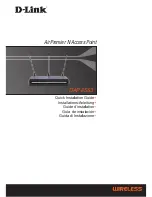
F5D8636-4_man updated by ARC
Page 57 of 121
bandwidth to 20MHz-only operation might solve some wireless problems. This is
the default mode for the Router.
Using the Broadcast SSID Feature
Note: This advanced feature should be employed by advanced users only. For
security, you can choose not to broadcast your network’s SSID. Doing so will
keep your network name hidden from computers that are scanning for the
presence of wireless networks. To turn off the broadcast of the SSID, remove the
check mark from the box next to “Broadcast SSID”, and then click “Apply
Changes”. The change is immediate. Each computer now needs to be set to
connect to your specific SSID; an SSID of “ANY” will no longer be accepted.
Refer to the documentation of your wireless network adapter for information on
making this change.
Protected Mode Switch
Protected mode ensures proper operation of N, draft 802.11n-compliant devices
on your wireless network when 802.11g or 802.11b devices are present or when
there is heavy 802.11g or 802.11b traffic in the operating environment. Use
protected mode if your network consists of a mix of Belkin N Wireless Cards and
802.11g or 802.11b cards on your network. If you are in an environment that
includes little to no 802.11g or 802.11b wireless network traffic, you will achieve
the best N wireless performance with protected mode OFF. Conversely, in an
environment with HEAVY 802.11g or 802.11b traffic or interference, you will
achieve the best N wireless performance with protected mode ON. This will
ensure N wireless performance is not affected.
802.11e/WMM (Wi-Fi® Multimedia) QoS
WMM, based on 802.11e QoS (Quality of Service), prioritizes important data on
your network, such as multimedia content and voice-over-IP (VoIP), so it will not
be interfered with by other data being sent over the network. This feature
requires other wireless devices, such as Wi-Fi phones or wireless laptops, to
support WMM for best results.
Changing the Wireless Security Settings
Your Router is equipped with the latest security standard called Wi-Fi Protected
Access™ 2 (WPA2™) and the legacy security standard called Wired Equivalent
Privacy (WEP). Your Router also supports the Wi-Fi Protected Setup (WPS)
specification, which simplifies the setup of a wireless network. WPS uses familiar
methodologies, such as typing in a
Personal Identification Number (PIN)
or
pushing a button, to enable users to automatically configure network names and
strong WPA2 data encryption and authentication. By default, your Router does
















































